

Spectradyne, and Spectradyne's staff, are very concerned about the
COVID-19 outbreak and its implications for people's health world-wide. While none of our staff are currently ill or have tested positive for exposure to the virus, we are watchful and encourage all to follow best practices to avoid contracting this disease and spreading it to others.
Back to table of contents
As a scientific problem, the virus that causes this disease, known as "severe acute respiratory syndrome coronavirus 2" (SARS-CoV-2), or alternatively "2019 novel coronavirus" (2019-nCoV), presents an interesting challenge. It was first sequenced by scientists in China, and later by other laboratories around the world. It is a single-strand RNA encapsulated virus closely related to the virus that caused SARS, a disease that was detected in humans in 2002-2004 but has not reappeared since.
TEM images of the virus can be found on the web, such as the one shown to the right, showing SARS-CoV-2 virus emerging from the cells of a human patient.
From a physical characterization standpoint, SARS-type coronaviruses are interesting: Coronavirus is enveloped and pleomorphic (variable size), with a "corona" of spike glycoprotein structures on its surface. The result is a polydisperse particle size distribution that spans approximately 80-120 nm in diameter, well within the size range of detection accessible by Spectradyne's nCS1. Researchers have used the nCS1 to quantify a broad array of virus, including influenza, HIV, lentivirus, adenovirus, adeno-associated virus (AAV), human simplex virus (HSV), murine leukemia virus (MLV) and many others including bacteriophage.
In one of the first demonstrations performed with the MRPS technology, we demonstrated the detection of T7 bacteriophage, a bacterial virus commonly used for phage display of random peptides, with a diameter of 55-65 nm in diameter, comparable to that of non-enveloped small viruses such as Hepatitis C (with a diameter of 55 nm). Bacteriophage concentrations are typically determined after amplification, concentration and purification of the phage, using biological titer, a process which typically requires a few hours. MRPS was used for the direct, rapid (few seconds) measurement of the size and concentration of T7 phage, an all-electronic analysis that does not require infectivity-based titration.
Spectradyne's nCS1TM could therefore easily be applied to the measurement of the diameter and concentration of SARS-CoV-2, although of course this should only be done in a properly equipped, BSL3 laboratory. We'd encourage researchers with these capabilities to consider the nCS1 as a rapid means for quantifying this virus.
Please continue to follow our blog as we share insights, technical details, and generally geek-out with you about nanoparticle science!
Email us for more information, or to discuss your particular application directly.

This scanning electron microscope image shows SARS-CoV-2 in yellow (also known as 2019-nCoV, the virus that causes COVID-19) isolated from a patient in the U.S., emerging from the surface of cells (blue/pink) cultured in the lab.